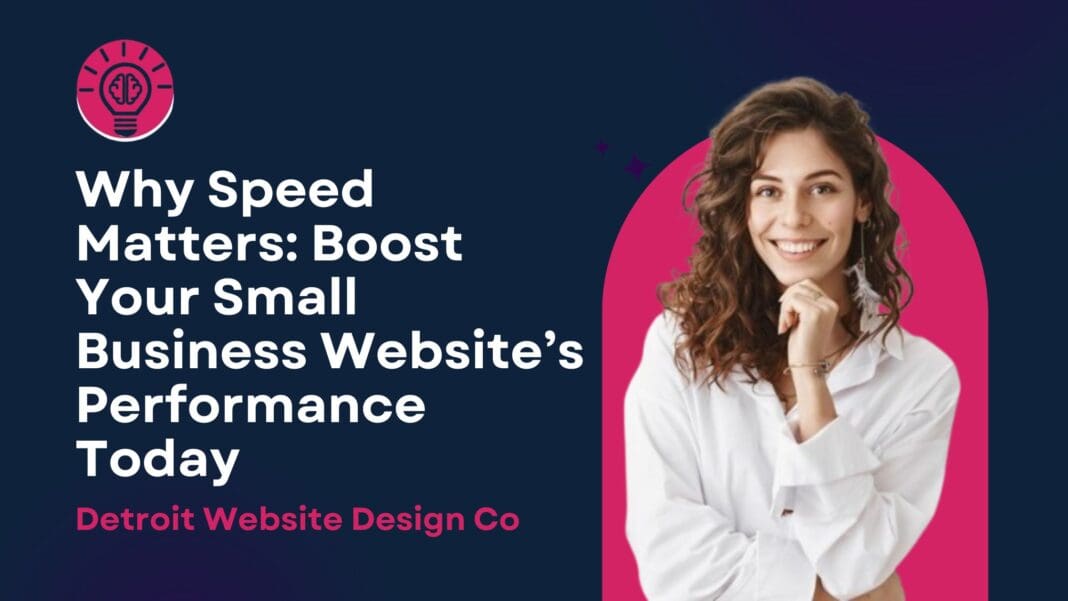In today’s fast-paced world, users expect instant gratification. Whether they’re browsing your products, reading your blog, or trying to contact you, they want it to happen quickly. As a small business owner, website speed plays a pivotal role in attracting and retaining customers. A fast-loading website not only improves user experience but also impacts your SEO rankings, conversion rates, and overall business performance.
At Detroit Website Design Co, we know that optimizing your website’s performance isn’t just a technical issue—it’s a strategic move that can help grow your business. Let’s dive into why website speed is crucial and how improving it can boost your small business.
1. First Impressions Matter
Mistake: Imagine this—someone visits your website for the first time, excited to learn more about your products or services, but they have to wait for several seconds for your pages to load. What happens? They hit the “back” button, frustrated and probably heading to a competitor’s faster site.
Solution: A fast-loading website creates a positive first impression. When a visitor arrives and your pages load within seconds, it shows professionalism and efficiency. On the flip side, slow-loading pages can make your business seem outdated or unreliable. Speed matters because it establishes trust right from the first click.
Pro Tip: Studies show that 47% of consumers expect a webpage to load in two seconds or less. If it takes longer, you risk losing potential customers.
2. Website Speed and SEO: A Vital Connection
Mistake: Many small business owners think SEO only involves using the right keywords or creating quality content. While those are important, website speed also plays a key role in how Google ranks your site.
Solution: Google has made it clear—website performance is a ranking factor. Websites that load quickly are more likely to appear higher in search results, meaning more visibility and more organic traffic for your business. Page speed is an essential component of technical SEO, and search engines like Google consider it when determining where your website should rank.
Google’s Core Web Vitals assess user experience based on factors like page loading speed, interactivity, and visual stability. By ensuring your website meets these standards, you’ll not only improve user experience but also boost your chances of ranking higher in search results.
Pro Tip: Use tools like Google PageSpeed Insights to identify areas where your website’s performance can be improved. Optimizing these areas can give you a competitive edge in search engine rankings.
3. Improved User Experience = Increased Engagement
Mistake: Slow-loading websites frustrate visitors, leading to a high bounce rate. A high bounce rate occurs when users leave your site quickly after it loads, indicating poor user experience.
Solution: Fast page load times are crucial for positive user experience (UX). When your website loads quickly, users are more likely to stay, explore, and engage with your content. Whether it’s browsing products, reading blog posts, or completing a contact form, the quicker your site responds, the more likely visitors will interact.
Pro Tip: Focus on providing a smooth and seamless experience by reducing page load times, making navigation simple, and ensuring your website is mobile-friendly. These adjustments can improve engagement metrics like time on page and pages per session.
4. Higher Conversion Rates = More Revenue
Mistake: Slow websites can directly affect your conversion rates. If your pages take too long to load, visitors may leave before completing their purchase, signing up for a newsletter, or filling out a contact form.
Solution: Website speed has a direct impact on conversion rates. According to a study by Google, 53% of mobile users will abandon a page if it takes longer than three seconds to load. This means that every second your website lags could result in a lost opportunity.
By optimizing your website speed, you can:
- Increase form submissions: Users are more likely to complete contact or lead-generation forms if they aren’t kept waiting.
- Boost sales: Fast-loading eCommerce sites can improve conversion rates by reducing friction in the buying process.
- Encourage repeat visits: Visitors are more likely to return to a fast, seamless website.
Pro Tip: Test your conversion funnel and identify any points where slow load times may be causing visitors to drop off. Optimizing your site for speed can lead to higher ROI.
5. Mobile Experience Matters More Than Ever
Mistake: Many small business owners focus primarily on desktop performance and overlook the mobile experience. In today’s mobile-first world, mobile optimization is a must.
Solution: Mobile web browsing continues to grow rapidly, and if your site is slow to load on smartphones or tablets, you’re losing valuable customers. A mobile-optimized website that loads quickly can improve user engagement, customer satisfaction, and ultimately, your conversion rates.
In fact, Google ranks mobile-friendly websites higher in mobile search results, so optimizing your site for mobile speed is essential not only for user experience but also for SEO.
Pro Tip: Use responsive design to ensure your website automatically adjusts to different screen sizes and ensure it loads quickly across all devices. A mobile-optimized website is key to boosting user retention and driving more sales.
6. Website Speed Affects Your Reputation
Mistake: If users find your website slow and unresponsive, they might believe your business is outdated or unprofessional. A negative reputation can be hard to overcome.
Solution: Fast website speed translates to a positive user perception. It shows that you care about your customers’ experience and are committed to providing the best possible service. A well-performing website enhances your reputation as a professional, reliable business.
Pro Tip: Keep track of user feedback regarding your site’s performance. If customers complain about speed issues, prioritize improvements to prevent potential reputation damage.
7. Reduced Bounce Rates = More Traffic Retention
Mistake: Slow websites are more likely to experience high bounce rates, meaning users leave quickly after visiting the site.
Solution: By improving your website speed, you reduce the chances of visitors bouncing off your site. Retaining traffic is crucial for growth—especially if you’re investing in paid ads or SEO strategies to drive visitors to your site.
A faster website helps keep users engaged, encouraging them to spend more time exploring your content, services, or products. The longer visitors stay, the higher the chances of conversion.
Pro Tip: Implement caching strategies and optimize media files (images, videos, etc.) to reduce page load times and improve retention.
How Detroit Website Design Co Can Help
At Detroit Website Design Co, we specialize in website performance optimization. Whether you’re running an eCommerce store or a service-based business, we can help you:
- Speed up your website for better performance and user experience.
- Optimize images and code to ensure faster load times.
- Implement mobile-friendly designs to improve accessibility and SEO.
If you’re ready to take your website’s performance to the next level and improve your online success, Detroit Website Design Co is here to help.
Conclusion
Website speed is more than just a technical feature—it’s a critical component of user experience, SEO, and conversion rates. In 2025, fast websites are a must for small businesses aiming to stay competitive and grow. If your website is sluggish, it’s time to take action and boost its performance.
Don’t let slow load times drive potential customers away. Optimize your website today and start seeing the benefits of improved engagement, higher rankings, and more conversions. At Detroit Website Design Co, we have the tools and expertise to help you achieve a faster, more successful website.








